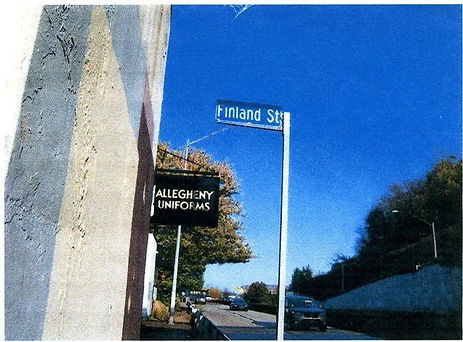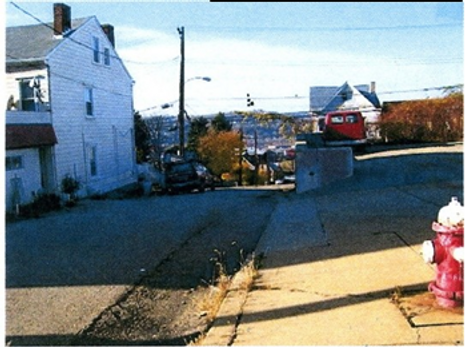top of page
PITTSBURGH FINNS

Finnish Room Committee, University of Pittsburgh Pittsburgh Chapter, Finlandia Foundation
.png)

We are a social group composed of about 80 members. Membership is open to anyone with an interest in Finnish culture. We participate in community events, sponsor social events, and publish a newsletter. We are both a University of Pittsburgh Nationality Rooms committee and a Finlandia Foundation chapter. We often co-sponsor events with the Scandinavian Society of Western Pennsylvania. In addition, we are involved in a project to build a Finnish Nationality Room in the University of Pittsburgh's Cathedral of Learning, to join the existing Nationality Rooms.
A History of
Finns in Pittsburgh and the Pittsburgh Finns


Finland Street and Finn Hall
A long time ago there was a Finn Hall in Pittsburgh. A reminder of it is still there, a small street named Finland Street. We do not need to go far to find places where Finnish people have built homes, halls and churches.
Sylvia Rinne sat in her wheelchair almost all day waiting for someone to drop by for a visit. They were nice visits with her being happy to have company. She had lived in Pittsburgh all her life and remembered what life was like during her childhood. This story about Finn Hall was taped during one of those visits. The hall was there when she was a child; it was not clear when it disappeared.
Activities in Finn Hall in the Hill District in Pittsburgh
Kuppi kuumaa
By Sylvia Rinne
I was about 10 years old when I started to go to the Finnish dance with my parents on Saturday evenings. I was one of five children, about the same age, who came there before the dance started. My mother was in the kitchen where the women made coffee and prepared cardamon sweet bread, "pulla", and red salmon sandwiches, "lohivoileipi". We children went to the kitchen and were offered a big cup of coffee, "kuppi kuumaa", as was said. We drank our coffee and then we went to the hall, a large room on the second floor of the building. There we played until the musicians, Helen, Heikki, and their young brother, Lauri, came to play. Helen played the piano and Lauri played the violin. Then came a loud "pum, pum, pum," when Heikki hit the drums. The father of the two girls whom I was playing with came and danced with us children. We danced all over the floor and had fun. Especially we enjoyed when the musicians played the polka. More people arrived, and the dance had started. Young men and women, wives and husbands, came to dance. Every Saturday they came there to meet each other and to dance. The music played beautifully, and the people had a good time. Then came a man who had an accordion, "hanuri". He started to play. The music came out and one felt like the feet would dance almost by themselves. However, we, the children, had to sit aside when the big people filled the dance floor. In the kitchen there was a big coffee pot always hot and Finnish "pulla" and lox-sandwiches were available. Once tired of dancing, people came there and had a "kuppi kuumaa", a cup of hot coffee, and a chance to sit down and talk with friends. My parents did not dance. Mother was in the kitchen and served coffee. Father had a good singing voice and was often asked to sing. "Matti !aula meille!" people said. And father sang. It was beautiful, and we all enjoyed listening. Then the music started again and the feet carried on and on. The music stopped at eleven, and about twelve o'clock the rooms had been cleaned and we were ready to lock up and leave for home. However, the warm and happy feeling which had surrounded us in that place stayed with us, and it still brings back happy memories to remember these Saturday evenings now when there are only a few Finnish people left in Pittsburgh. In the summertime dances were not held regularly. Instead people often came to our house in Brookline. My brother had built a sauna underneath a garage building in our backyard. On Saturdays many Finnish people came to get a good sauna bath. The sauna was heated hot and people sitting on the benches threw water on the kiuas-stones. Hot steam filled the room and the bathers hit themselves with leafy branches. Finally they ran to a cold refreshing shower and, after having cooled themselves, they got dressed and came up. There in the house were coffee and bread and of course Finnish coffee pulla. It was the "kuppi kuumaa", a cup of hot coffee, which was always ready when the people gathered together. If there was a dance that night, the sauna bath was taken early and we went to the dance afterwards. Summer was also a time for picnics. The area around our house was mostly unbuilt forest and nearby was an open place for games. About the second Sunday of the month the people came again. The cars were parked on the streets near our house, and from our backyard we went through the forest to the picnic area. There people played games, baseball and horseshoes. A campfire was built on stones, and everybody had fun. We children could run freely in the woods and the time to go home in the evening came always too soon; even so, we were tired and ready to go to sleep.
The Finnish Nationality Committee
The Finnish Nationality Committee at the University of Pittsburgh was started by Eva Niemela Passoja, who had attended California University of Pennsylvania. The Niemela family, from Monessen, PA, had founded a farm and were members of the Monessen St. Luke's Lutheran Church. The church followed the practices of the Finnish Lutheran Church. Pastors came from Finland and the Finnish language was used in services as well as taught in the church school until the 1970's. Eva's husband, Paul Passoja, had played in the Monessen High School Band, then gone to study music in New York and West Virginia, and returned to Monessen, becoming the leader of the band. He also had a Master of Music degree from Duquesne University and took over the leadership of the Louhi Band in Monessen, an orchestra that played Finnish music and gave many performances including some in New York and Finland. In 1938, the band performed in Chester, Delaware in the 300th anniversary celebration of the founding of the New Sweden Colony.
The Niemela family was active in the Finnish Nationality Committee and made sure that there was a little Christmas tree decorated every year in the Cathedral of Learning, in the gift shop in the Commons Room on the first floor. They brought decorations from their home. Everett, Eva's brother, who had a Master of Education degree from the University of Pittsburgh and taught woodworking, made shiny apples and other decorations. Some of the decorations were similar to those in Finland available in markets in the 1900's.
From Nationality Committee to Room Committee
Then in 1982, Seija Cohen became the chairman of the Finnish Nationality Committee. She had arrived in the USA in 1969 after marrying Alvin Cohen, Professor of Geochemistry at the University of Pittsburgh in Oakland. After that, the Committee started collecting dues from members and some income came from sales at Christmas parties, which were held annually and became the most important event of the Committee.
FinnFest USA also started at the same time. Outstanding programs were given by scholars both from American universities and from Finland. In addition to lectures, musicians, musical groups, folk dancers and plays were part of the FinnFest programs. To the American Finns, this was an important get-together where friendships and relations were formed between relatives and Finns from all over the USA.
Many lecturers were brought to the University of Pittsburgh from these connections. For example, Professor Anja Olin-Fahle of the Indiana University of Pennsylvania presented a talk written by Dr. Eino Friberg, who translated the Kalevala into American English. Professor Juha Pentikainen, from the University of Helsinki, Finland, writer of the book "Kalevala Mythology", presented his book at the Pitt Book Store and was a visitor at a luncheon of the Women's International Club of the University of Pittsburgh. Matti Tuloisela, baritone, and Tapio Tiitu, organist, gave a concert in Heinz Chapel. Professor Ralf Jalkanen, President of Suomi College in Michigan, visited the University and was honored at an event at University Inn. The Scandinavian Society of Western Pennsylvania (SSWP) was a cosponsor in bringing FinnFest Performers of the Year to the area.
The Finnish Room Committee also gave a scholarship for study of the kantele, a traditional Finnish instrument, in Finland. The winner of this scholarship attended a kantele course in Lahti, Finland.
In 2003 the required $5000 was collected and the Committee was able to apply to build a Finnish Nationality Classroom in the Cathedral of Learning. With an impressive list of events and cultural programs on its application, the application was approved. The Committee now became a Room Committee and started to develop a room design where cultural values in the Finnish history would be showcased.
Recognized far and wide, the historic Nationality Rooms at the University of Pittsburgh are seen by tens of thousands of visitors each year through a vibrant tour program. They give a profound sense of the diverse ethnic backgrounds of Western PA. The Rooms, currently 31 in number, are a source of pride for each group represented and also serve as classrooms at the University.
bottom of page

